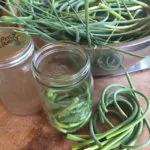By using these five simple tips to care for and store fermented vegetables, you will reduce mold issues and enjoy your delicious lacto-fermented foods longer.
You’ve made your first big batch of sauerkraut, successfully turning many heads of cabbage into a delicious and nutritious food that you will enjoy for months. Now what?
What is the best way to store and care for your sauerkraut to keep it tasting great and to avoid mold issues? What about half-finished jars? Is there anything special you need to do to your ferments?
Fermentation doesn’t have to be fussy, but if you’re looking to store your homemade ferments for a long period of time – for example, storing your homegrown cabbage as sauerkraut all winter long – you’ll achieve better results by investing a bit of effort into management.
Even smaller batches of fermented vegetables that will get eaten up more quickly are worth a bit of thought.
{If you’re wanting some more coaching on the basics of fermentation, try this post and this one!}
How to store and care for vegetable ferments:
1) Store ferments in a cool place
When a ferment is “done,” which means that it tastes sour enough for you, move it into cool storage. A refrigerator, the basement, a root cellar, or even the coolest corner of your kitchen will work.
If a ferment is not placed into cool storage, the food will continue to ferment, which isn’t a bad thing necessarily, but it may become too sour or too soft for your liking.
Knowing that the fermentation process will slow down, but continue in cool storage, I like to move my fermented vegetables into the root cellar before they are at my ideal level of sour.
2) Watch brine levels!
As in the initial fermenting stage, it is equally important to maintain brine levels in your finished ferments. Sometimes, all that’s needed is an occasional pressing down on the fermented vegetable.
Other times, more brine must be added. You can use newly made salt brine or you can use some brine from another ferment for topping up when you’ve finished them. Or combine half-finished jars (see below) so that brine levels remain high.
3) Reduce air space/Eat out of smaller jars
We’ve found consistently that the more air space in a jar, the more likely it is to develop mold growth. So we always repack ferments into smaller containers as we eat them.
For example, as we eat into a gallon jar of kraut, we might soon decide to repack some of it into a half-gallon jar and the rest into a quart jar and eat out of that.
Then once we dig into the half-gallon, we might soon repack that into two-quart jars and eat only from one at a time. Since finished ferments are usually less bubbly and active, tighten the lids, top off the brine, and put the jars back into cool storage.
4) Combine Ferments
Many times we end up with an assortment of small quart batches of finished fermented vegetables, and we sometimes decide to combine them into “blends” so we could store them in larger gallon jars. Who knows, maybe we’ll end up with a flavor combination that’s even better than what we started with!
5) Use a Stronger Brine for Long-Term Ferments
If you know you will be storing a ferment for a longer time through the winter, you can use a bit more salt to create a stronger brine. Sandor Katz’s excellent books The Art of Fermentation and Wild Fermentation both talk about the varied brine strengths and how to get to those salt percentages.
By using these five simple tips to store and care for your vegetable ferments, you will reduce mold issues and enjoy your delicious lacto-fermented foods longer.
Ready to start fermenting?
Try one of these easy recipes:
How to Make Lacto-Fermented Pickles
“Did you find this article on how to care for and store fermented vegetables useful? Share it with a friend or Pin it!”












Hi ! Hope you can help me – I did my first batch of fermented cucumbers and wanted to reuse the brine – towards the end of eating the 1st lot we had it stored in the frigerator so the brine had been chilled. When I cut up my cauliflower, etc. I put it in a regular jar, weighted it down with a drink lid and poured my brine over, capped it and put it in the frigerator – will this work? I re-used my special fermenting jar with the gas release top to make a brand new from scratch batch and just put that in a cool, dark spot like I did originally. So I’m wondering/hoping that since my 1st brine was already fermented it will work it’s magic on the new veggies in the jar in the frig…..as of right now 7/10/22 at 4:30 pm they have been in the frig about 28 hrs. Any help will be greatly appreciated as I have listened to/read many articles and they don’t answer my question
I have always created a fresh batch of brine and used about 3/4 fresh brine and 1/4 used brine to “innoculate” the new ferment. You want to make sure when you start that the salt-water to veggie ratios promote good bacteria flourishing. Although if you’re placing it right into the fridge, then you’re probably looking at more of a “quick pickle” scenario. The actual lactofermentation process will need more warmth to get started – you place it in the fridge when it’s close to the ideal sour taste for your liking.
Thanks!👍🤗
Once my ferment is done, do the jars I put it in need to be sealed in anyway other than just screwing the lid on, like a preserve etc? It’s likely that the batch will last me a long time and I don’t want it going moldy in the mean time!
That’s correct – once they are done, just use a normal lid! They will last longer in cooler storage, so if you have refrigerator space, that’s great. If not, find your coolest spot for storage, and check often to make sure the ferment remains below the liquid.
I’m just learning about fermenting. I live in a very small 1910 home that does have a basement. How cold does it need to be to store the food. I do not have a “normal” size fridge and will only be able to store open jars tidy we are currently eating in it. Thank you
Your basement would work well for larger crocks. We have kept fermented food in our root cellar for months, and the temperature has varied from 30-60 degrees F.
Hi I have just made my first batch of fermented cabbage.
Can i store it in a plastic container?
Yes, you can, although I like to store mine in glass, because I find that the fermented taste is almost impossible to get out of the plastic later on, and I’m not a huge fan of the chemicals that can leach out of plastic. We store ours in wide-mouth mason jars.
My cole crops always get full of bugs. what do you do so they look so pretty ? . I almost want to just grow them in the fall/winter.
They don’t always look pretty!! I have to pick off cabbage worms all through June! But they seem to be doing well now. We have a much harder time with cucumbers and squash pests.
This was super helpful! I’m constantly forgetting my kraut in the crock and end up feeding the rest to the pigs because it goes past where I like to eat it. Plus, if I do a small batch and leave it too long, I inevitably end up with mold somewhere. I still don’t own Katz’s book – I’ve checked it out from the library but I need to own one so I can remember all those cool, little details that I constantly forget. Thanks, Teri!
Glad it was helpful, Tessa! I only like my krauts very crisp, so I ferment for only a few days to a week and then store in the cooler. So much yummier!